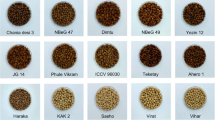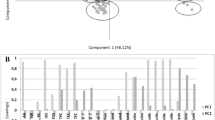Abstract
We examined the physical, physicochemical, and cooking properties of 91 kabuli chickpea landraces from Turkey, using two cultivars (İnci and İzmir-92) as controls. All landraces were grown under the same agroclimatic conditions to eliminate variance caused by genotype × environment interactions. There was high diversity among the landraces in the contents of protein (17.55–23.31%), fat (4.45–6.11%), ash (2.54–3.41%), fiber (2.03–4.18%), starch (41.76–49.07%), moisture (6.39–10.57%), 100-seed weight (25.03–51.67 g), hydration capacity (0.2585–0.6169 g/ml), swelling index (0.7207–1.1859), swelling capacity (0.15–0.32 ml seed−1), cooking time (33–72 min), and seed density (0.8450–1.4800 g/ml). Regional analysis of landraces showed significant differences with respect to nutritional characteristics and cooking parameters. There were also significant relationships between various seed quality and cooking parameters. Together, our results provide an initial step toward identification of chickpea landraces that may be useful for development of high-quality chickpea cultivars.
Similar content being viewed by others
References
AOAC (1984) Official methods of analysis, 14th edn. Association of Official Analytical Chemists, Washington, DC
Badshah A, Khan M, Bibi N, Khan M, Saijad A, Chaudry MA, Khattak MS (2003) Quality studies of newly evolved chickpea cultivars. Adv Food Sci 25:95–99
Bibi N, Khattak AB, Khattak GSS, Mehmood Z, Ihsanullah I (2007) Quality and consumer acceptability studies and their inter-relationship of newly evolved desi type chickpea genotypes (Cicer arietinum L.). Quality evolution of new chickpea genotypes. Int J Food Sci Technol 42:528–534
Chavan JK, Kadam SS, Salunkhe DK (1986) Biochemistry and technology of chickpea (Cicer arietinum L.) seeds. CRC Crit Rev Food Sci Nutr 25:107–158
Clemente A, Sánchez-Vioque R, Vioque J, Bautista J, Millán F (1998) Effect of processing on water absorption and softening kinetics in chickpea (Cicer arietinum L.). J Sci Food Agric 78:169–174
Coşkuner Y, Karababa E (2003) Effect of location and soaking treatments on the cooking quality of some chickpea breeding lines. Int J Food Sci Technol 38:751–757
Ercan R, Köksel H, Atli A, Dağ A (1995) Cooking quality and composition of chickpea grown in Turkey. Gida 20(5):289–293
FAOSTAT (2008) http://faostat.fao.org/site/567/default.aspx#ancor
Gil J, Nadal S, Luna D, Moreno MT, Haro AD (1996) Variability of some physico-chemical characters in desi and kabuli chickpea types. J Sci Food Agric 71:179–184
Iqbal A, Khalil IA, Ateeq N, Khan MS (2006) Nutritional quality of important food legumes. Food Chem 97:331–335
Jood S, Bishnoi S, Sharma A (1998) Chemical analysis and physico-chemical properties of chickpea and lentil cultivars. Nahrung 42:71–74
Kaur M, Singh N, Sodhi NS (2005) Physicochemical, cooking, textural and roasting characteristics of chickpea (Cicer arietinum L.) cultivars. J Food Eng 69:511–517
Khattak AB, Khattak GSS, Mahmood Z, Bibi N, Ihsanullah I (2006) Study of selected quality and agronomic characteristics and their interrelationship in kabuli-type chickpea genotypes (Cicer arietinum L.). Int J Food Sci Technol 2:1–5
Krouma A (2009) Physiological and Nutritional response of chickpea (Cicer arietinum L.) to salinity. Turk J Agric For 33:503–512
Patané C (2006) Variation and relationship among some nutritional traits in sicilian genotypes of chickpea (Cicer arietinum L.). J Food Qual 29:282–293
Ravi R, Harte J (2009) Milling and physic-chemical properties of chickpea (Cicer arietinum L.) varieties. J Sci Food Agric 89:258–266
Rockland LB, Jones FT (1974) Scanning electron microscope study on dry beans. Effect of cooking on cellular structure of cotyledons in rehydrated lima beans. J Food Sci 39:342–346
SAS Institute (2002) The SAS system for Windows. Release 8.2. SAS Institute, Cary, NC
Sefa-Dedeh S, Stanley DW (1979) Textural implications of the microstructure of legumes. Food Technol 33:77–83
Shad MA, Pervez H, Zafar ZI, Zia-Ul-Haq M, Nawaz H (2009) Evaluation of biochemical composition and physicochemical parameters of oil from seeds of desi chickpea varieties cultivated in arid zone of Pakistan. Pak J Bot 41(2):655–662
Singh U (1985) Nutritional quality of chickpea (Cicer arietinum L.): current status and future research needs. Plant Food Hum Nutr 35:339–351
Singh U, Subrahmanyam N, Kumar J (1991) Cooking quality and nutritional attributes of some newly developed cultivars of chickpea (Cicer arietinum). J Sci Food Agric 55:37–46
Singh N, Sekhon KS, Bajwa U, Goyal S (1992) Cooking and parching characteristics of chickpea (Cicer arietinum L.). J Food Sci Technol 29:347–350
Singh KB, Bejiga G, Malhotra RS (1993) Genotype-environment interactions for protein content in chickpea. J Sci Food Agric 63:87–90
Singh GD, Wani AA, Kaur D, Sogi DS (2008) Characterisation and functional properties of protein of some Indian chickpea (Cicer arietinum L.) cultivars. J Sci Food Agric 88:778–786
Singhai B, Shrivastava K (2006) Nutritive value of new chickpea (Cicer arietinum) varieties. J Food Agric Environ 4:48–53
Sotelo A, Flores F, Hernandez M (1987) Chemical composition and nutritional value of Mexican varieties of chickpea (Cicer arietinum L.). Plant Food Hum Nutr 37:299–306
Toker C (2009) A note on the evolution of kabuli chickpeas by induced mutations in Cicer reticulatum Ladizinsky. Genet Res Crop Evol 56:7–12
Waldia RS, Singh VP, Sood DR, Sardana PK, Mehla IS (1996) Association and variation among cooking quality traits in kabuli chickpea (Cicer arietinum L.). J Food Sci Technol 33:397–402
Wang N, Hatcher DW, Warkentin TD, Toews R (2010) Effect of cultivar and environment on physicochemical and cooking characteristics of field peas (Pisum sativum). Food Chem 118:109–115
Williams PC, Singh KB, Nakkoul H (1983) Relation of some physical aspects of kabuli type chickpeas to cooking time. J Sci Food Agric 34:492–496
Zia-Ul-Hak M, Ahmad M, Iqbal S, Ahmad S, Hakoomat A (2007) Characterization and compositional study of oil from seeds of desi chickpea (Cicer arietinum L.) cultivars grown in Pakistan. J Am Oil Chem Soc 84(12):1143–1148
Acknowledgement
This study was supported by the Scientific and Technological Research Council of Turkey (TUBITAK; project no. TOVAG-104O441).
Author information
Authors and Affiliations
Corresponding author
Rights and permissions
About this article
Cite this article
Özer, S., Karaköy, T., Toklu, F. et al. Nutritional and physicochemical variation in Turkish kabuli chickpea (Cicer arietinum L.) landraces. Euphytica 175, 237–249 (2010). https://doi.org/10.1007/s10681-010-0174-3
Received:
Accepted:
Published:
Issue Date:
DOI: https://doi.org/10.1007/s10681-010-0174-3




